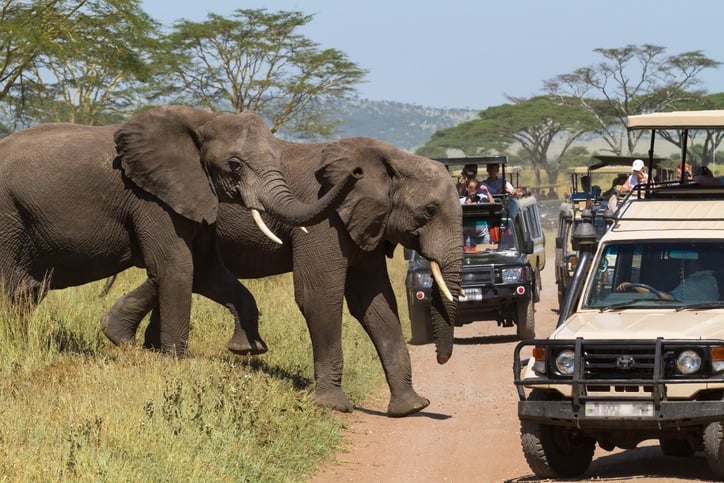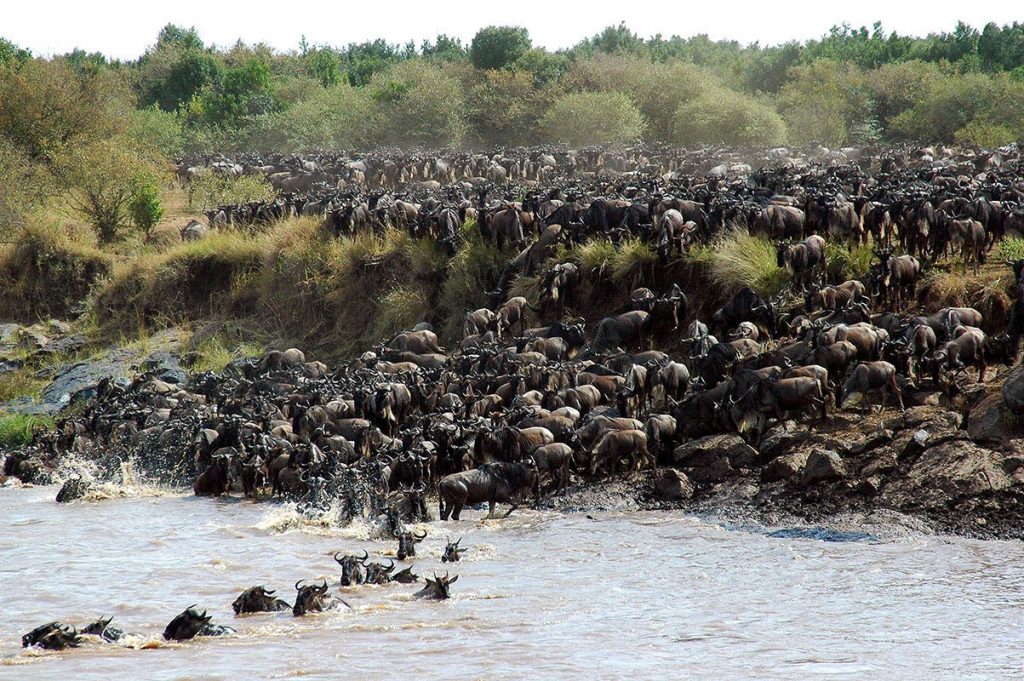How Can I Get to Serengeti National Park?
How Can I Get to Serengeti National Park? Serengeti National Park is Tanzania’s crown jewel and Africa’s most celebrated safari destination, famous for the Great Migration. Located in northern Tanzania, the Serengeti unfolds like a living epic of plains, predators, and the Great Migration. It might feel like a faraway dream, but reaching the park is more straightforward than you would expect. Spanning over 14,750 square kilometers, Serengeti National Park stretches across northern Tanzania, bordering Lake Victoria to the west and the Ngorongoro Conservation Area to the southeast, with Kenya’s Masai Mara bordering its northern edge. Serengeti National Park can be accessed from Arusha, the safari capital of northern Tanzania, located about 355 kilometers away, depending on which park gate you are using.
Whether you are a luxury traveler flying in by bush plane or a classic adventurer on the open road, multiple access points make getting to Serengeti National Park seamless, safe, and scenic. Like any other journey, your journey to the Serengeti will begin with choosing the right route, including travel by air, by road, or a combination of both, all tailored to your safari plans, time, and budget. Let’s explore how to get there and what you need to know to arrive ready for the wild.

-
Getting to Serengeti National Park by Air
Flying is the fastest and most efficient way to reach Serengeti National Park, especially for travelers short on time or seeking direct access to remote lodges.
International Travel
Most international visitors to the Serengeti arrive via Kilimanjaro International Airport (JRO), located 1 to 2 hours ‘ drive from Arusha. Kilimanjaro Airport is one of Tanzania’s major airports, connecting with major hubs like Amsterdam (KLM), Doha (Qatar Airways), Istanbul (Turkish Airlines), and Nairobi (Kenya Airways). Alternatively, Julius Nyerere International Airport (DAR) in Dar es Salaam serves as another entry point for those continuing to Zanzibar or southern Tanzania.
From Kilimanjaro International Airport, travelers are then able to connect to the Serengeti via regional flights.
Domestic and Regional Travel
Domestic and regional travel is arguably the quickest way to get to Serengeti National Park. There are small aircraft available at Arusha or Kilimanjaro airports that offer daily flights into Serengeti’s many airstrips. Top aircraft to use include Grumeti Air or Coastal Aviation, Auric Air, and Flightlink, to name a few. Depending on your lodge’s location, you might land at Seronera (central), Kogatende (north), Grumeti (west), Ndutu (south), or other airstrips. Flight times range from 1 to 1.5 hours, and schedules are designed to sync with the arrival times of international flights. Upon landing at your designated airstrip, you will be picked up by your guide or lodge staff and transferred to your lodge or camp in a 4×4 vehicle.
The beauty of flying to Serengeti is that you bypass the long drives and enjoy breathtaking aerial views of the Great Rift Valley, Maasai villages, and herds meandering across the park’s plains.
Private Fly-In Safaris
Private fly-in safaris in Serengeti National Park are luxury fly-ins often organized by luxury lodges and mobile tented camps, where guests are transferred directly to airstrips near the property. These private charters offer time efficiency and exclusivity, and the aircraft can land on smaller airstrips not served by commercial bush flights. While they are more expensive, private fly-in safaris are ideal for high-end itineraries and romantic getaway safaris.
-
Getting to Serengeti National Park by Road
Driving to Serengeti National Park is an adventure in itself, and while it takes longer than flying, it offers an immersive view of Tanzania’s landscapes and often includes stopovers at other iconic safari destinations.
Private Drive-In Safaris
Most overland safaris to the Serengeti start from Arusha, Tanzania, in a 4×4 safari vehicle with a professional guide. The journey takes about 7 to 8 hours to reach the park’s Naabi Hill Gate (Serengeti’s main southern entrance). This route takes you through Lake Manyara National Park and the Ngorongoro Crater en route, and depending on how much time you have, these stops create a classic northern circuit safari experience, often split into multi-day itineraries.
The advantage of a drive-in safari lies in flexibility and immersion, as guides can detour through scenic spots for sightseeing, stop for wildlife viewing, and help you understand the local culture. Once you have reached the park, you will continue driving toward your lodge or campsite, often encountering wildlife from the moment you enter.
Self-Drive Safaris
For the more adventurous travellers who enjoy solitude, self-driving experiences to Serengeti National Park are possible. Travelers can rent a 4×4 vehicle from reputable tour operators or vehicle hire service providers in Arusha or Mwanza and plan their route. However, a self-driving safari to Serengeti National Park requires careful planning, mastering navigation, acquiring park permits, fuel planning, and ideally, GPS assistance. Most travelers opt for a self-drive route entering from Naabi Hill, Ndabaka (Western Gate), or Klein’s Gate (Northeastern).
While budget-friendly and flexible, self-driving is best suited for experienced safari-goers who are familiar with remote travel conditions and national park protocols.

Serengeti National Park Access Gates
Serengeti National Park spans over 14,750 square kilometers, and entering the park through the proper gate can significantly reduce driving time and maximize wildlife viewing time. Serengeti has five main gates that are open daily from 6:00 a.m. to 6:00 p.m. (18h00), with last entry permitted at 4:00 p.m. (16h00) to ensure that guests reach their lodges before nightfall.
-
Naabi Hill Gate
This is the park’s busiest entrance, perched atop Naabi Hill at the Serengeti–Ngorongoro boundary. Just 45 km (about 1 hour) from Seronera and 30 minutes from Lake Ndutu, it offers sweeping views of the savannah and convenient amenities like a coffee shop, souvenir kiosk, and TANAPA/NCAA offices where you can pay park fees for both Serengeti and Ngorongoro.
-
Fort Ikoma Gate
Located on the northwestern edge of the park, Fort Ikoma gate is about a 1-hour drive from Seronera, 2 hours from Butiama, and 4 to 5 hours from Mwanza. Serving the Grumeti region, it is typically used by visitors coming from Tanzania’s western corridor. Facilities include TANAPA offices and restrooms for convenient fee processing and entry.
-
Ndabaka Gate
This western-access gate is about 145 km from Seronera and roughly 1.5 hours from Mwanza, situated along the Mwanza – Musoma route. This gate is often selected by travelers coming from Lake Victoria or Mwanza, entering the Western Corridor region. Electronic payments are also accepted at the gate.
-
Klein’s Gate
Set in the northeastern wilderness near Loliondo and Maasai-managed lands, Klein’s Gate is ideal for visitors arriving from Kenya’s Masai Mara National Reserve or via Lobo/Klein’s Camp airstrips. It provides access to the remote and predator-rich northern region of the Serengeti.
-
Handajega Gate
Situated in the southwestern corner near Mwanza and Kirawira B airstrip, the Handajega Gate is rarely used but allows both road and air access, mainly for lodges in the Grumeti area or arriving from the Musoma/Mwanza region.
Why Timing and Gate Choice Matter when Visiting Serengeti National Park
- All gates open at 6:00 m. and close at 6:00 p.m., with last vehicle admission at 4:00 p.m. to ensure guests reach lodges before dark.
- Missing the admission window may delay you until the following morning, adding potential extra time and cost.
- Selecting the gate nearest to your lodge or planned route minimizes internal park driving and ensures you arrive in time for late-evening game viewing or check-in.
Serengeti National Park Entry Fees
All visitors to Serengeti National Park are required to pay park entry fees, regulated by the Tanzania National Parks Authority (TANAPA). As of the latest guidance:
- Non-resident Adult: $70 – $80 USD per person per day
- Non-resident Children (5–15years): $20 – $30 per child per day
- Vehicle fee: Based on weight/type ($40 – $150) per vehicle per day
The Serengeti National Park entry fees are typically included in your safari package if booked through a tour operator or lodge. Tourism Development Levy (TDL) and concession fees may also apply, depending on your choice of accommodation. Always remember to carry proof of payment and a valid ID, as gate entry is strictly monitored. These fees contribute directly to park maintenance, anti-poaching, conservation, and community development.

